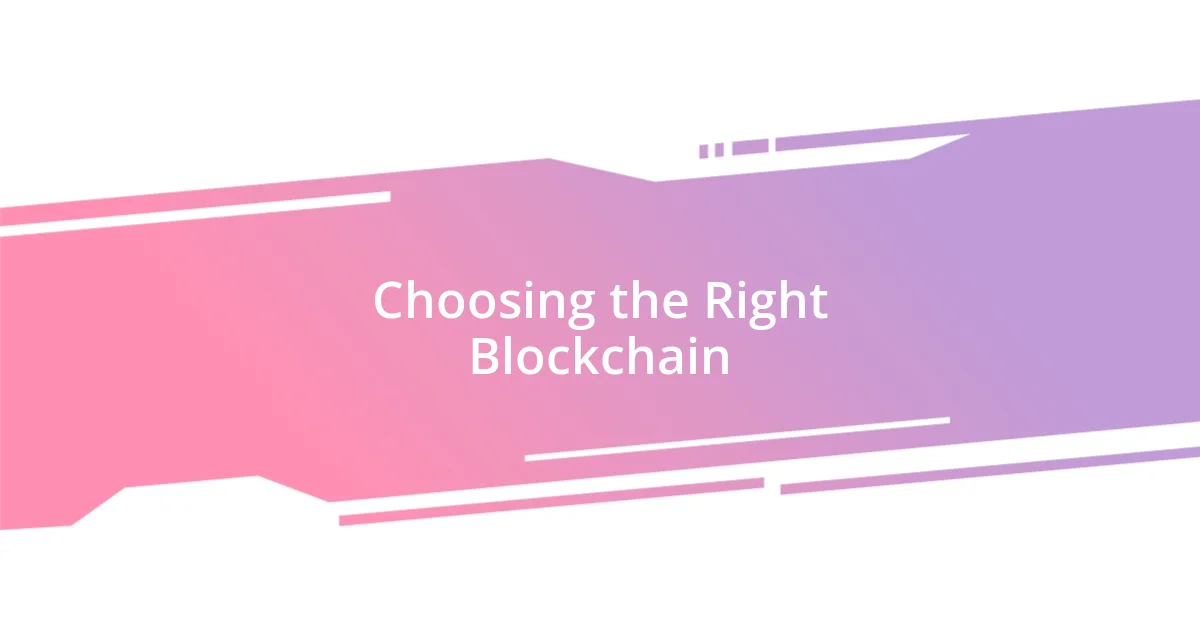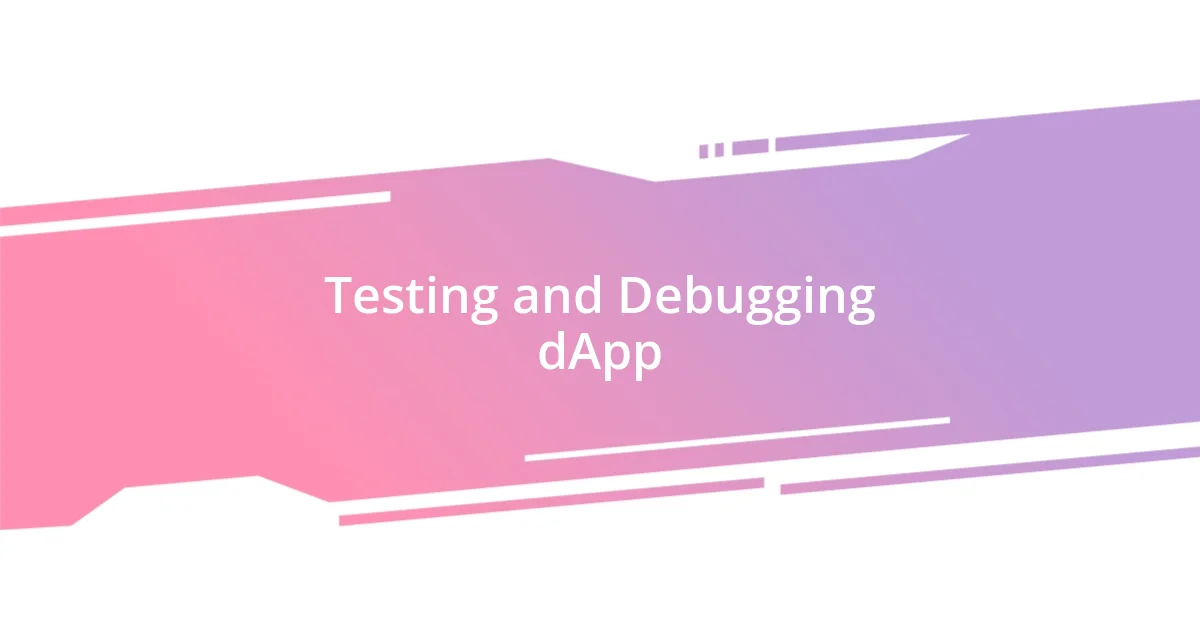Key takeaways:
- Understanding dApps involves grasping the concepts of decentralization and smart contracts, which empower peer-to-peer transactions without intermediaries.
- Choosing the right blockchain requires evaluating factors such as purpose, scalability, transaction fees, community support, and development language to align with your dApp’s goals.
- Testing and maintaining a dApp is crucial, emphasizing the importance of automated testing, peer reviews, and user feedback for continuous improvement and optimal performance.

Understanding dApp Fundamentals
When I first dived into the world of decentralized applications, or dApps, it felt a bit overwhelming. I had always been fascinated by the potential of blockchain technology, but understanding dApps required grappling with concepts like smart contracts and decentralization. Have you ever felt lost in a sea of new terminology? I certainly did, but the moment I grasped that dApps operate without a central authority, the thrill of the journey began to take shape.
One of the most compelling aspects of dApps is their reliance on smart contracts, which are essentially self-executing agreements coded onto the blockchain. When I created my first smart contract, it was like writing a recipe that could automatically deliver results without a chef at the stove! This built-in trust mechanism not only enhances transparency but also allows for peer-to-peer interactions without intermediaries, making it a transformative experience for anyone involved.
Moreover, the decentralized nature of dApps ensures that they are resistant to censorship and control. I vividly remember the first time I witnessed a transaction go through on a decentralized platform—a mixture of excitement and disbelief washed over me. It was empowering to realize that I was part of a movement pushing back against traditional gatekeepers. Understanding these fundamentals laid the groundwork for my development process and instilled a deep appreciation for the innovation that dApps represent.

Choosing the Right Blockchain
Choosing the right blockchain is a pivotal step in building your dApp. With so many options available, I recall sitting at my desk, overwhelmed with the choices. Each blockchain brings its own characteristics, trade-offs, and potential. I had to prioritize my dApp’s goals, whether it was speed, scalability, or security.
Here’s a handy checklist to consider when choosing your blockchain:
- Purpose: What is the primary function of your dApp? Are you focusing on finance, gaming, or identity verification?
- Scalability: Can the blockchain handle the expected number of transactions?
- Transaction Fees: What are the costs associated with using the blockchain? Will fees impact user experience?
- Community and Support: Is there an active community or documentation that can aid your development journey?
- Development Language: What programming languages are supported on the blockchain? Ensure you’re comfortable coding in them.
Reflecting on my decision, I remember sparking a conversation with fellow developers at a conference. Their insights helped me refine my choice, making it feel less daunting. It’s a journey filled with curiosity and collaboration!

Designing the User Interface
Designing the user interface for my dApp was an experience that blended creativity with functionality. I can’t stress enough how critical it is to prioritize user experience (UX). Early on, I found myself sketching wireframes on a notepad, trying to visualize how users would interact with my dApp. Have you ever felt a rush of inspiration when creating something from scratch? I did. Each line I drew represented a step toward making my vision a reality.
As I delved deeper, I realized that simplicity is key. Users often appreciate interfaces that are intuitive and easy to navigate. I remember spending hours tweaking buttons and layouts, ensuring they were not just aesthetically pleasing but also user-friendly. After all, if users struggle to engage, it’s not just a design flaw—it’s a failure in communication. A well-designed dApp should speak to its users.
Considering the various design directions, I started comparing different user interface frameworks. This helped me evaluate the best options for my specific needs. For instance, some frameworks prioritize mobile responsiveness, while others excel in customization. Below is a comparison table to illustrate these frameworks more clearly:
| Framework | Strengths |
|---|---|
| React | Component-based architecture for reusable UI components |
| Vue.js | Lightweight with an easy learning curve; great for beginners |
| Bootstrap | Provides extensive pre-built components, perfect for rapid development |
| Angular | Strong structure for large applications; robust tooling |

Developing Smart Contracts
Developing smart contracts felt like crafting a set of rules for a game I was deeply invested in. I remember pouring over Solidity documentation, excited yet apprehensive about transposing my logic into code. Each line of code had to be precise; even a small error could lead to costly repercussions. Have you ever felt that compelling urge to get everything just right? I certainly did, as each contract represented a fundamental component of my dApp’s functionality.
Debugging smart contracts was one of my more challenging experiences. I quickly learned that testing should be exhaustive, not just a box to check off. Tools like Truffle and Remix became my best friends, helping me simulate transactions to catch errors before going live. I often visualized these tests as dress rehearsals for a performance, where every mistake had to be corrected before the grand show. The pressure of wanting everything to function correctly before launch was palpable, but it was also a learning curve that sharpened my skills.
Once I felt confident in my smart contracts, deploying them on the testnet lifted a weight off my shoulders. It was like opening the door and stepping into a new world. I vividly recall the thrill of checking the block explorer, watching as my contracts went live. This moment of validation was priceless. Did all that effort pay off? Absolutely! Seeing my code working seamlessly in a simulated environment gave me the freedom to experiment and refine my dApp further. Each contract validated not just my technical skills but also my belief in the transformative power of blockchain technology.

Integrating Frontend and Backend
Integrating the frontend and backend of my dApp felt like bringing together the two halves of a heart. I remember feeling a mix of excitement and anxiety as I began to connect the user interface I designed with the smart contracts I developed. Using libraries like Web3.js helped bridge that gap, allowing me to interact with the Ethereum blockchain right from my frontend. Have you ever connected two pieces of a puzzle and felt that satisfying click? That’s how it felt every time I debugged a connection issue, knowing I was one step closer to completion.
There were moments when the integration felt like it was all happening in slow motion. I distinctly recall staring at my console, watching for errors as I made API calls to my backend. The thrill of successfully retrieving data and displaying it in real-time was almost euphoric; it reinforced my belief that I was on the right path. However, not everything was smooth sailing. I encountered CORS errors that made my heart race, but troubleshooting those became an unexpected learning adventure. I had to remind myself that every hiccup was just an opportunity to deepen my understanding.
Finally, setting up my state management with Redux was like adding a key ingredient to a recipe. It helped me maintain a predictable state across my application, simplifying my life tremendously. I can’t overstate how critical it was in managing the flow of data between components efficiently. Each time I saw the state update seamlessly and the user interface respond instantaneously, a wave of satisfaction washed over me. It’s moments like this that make the hard work worth it — the realization that I was creating a cohesive experience for my users. Isn’t that what it’s all about?

Testing and Debugging dApp
Testing and debugging my dApp felt like navigating through a maze. Each bug I encountered was a corner I needed to uncover—sometimes it took a while to figure out if the issue was with my frontend, the smart contract, or perhaps the way they communicated. I remember one instance where gas fees spiked during testing, and it took several days of head-scratching before I pinpointed the inefficiencies in my smart contract logic. It’s frustrating, isn’t it? But I realized that every challenge turned into an opportunity for growth.
I also embraced the power of automated testing. Frameworks like Mocha helped me run my tests quickly and simultaneously, which was a game-changer. This not only saved me time but also allowed me to catch mistakes I might overlook during manual testing. I recall a late night spent watching my tests run, the anticipation building with each passing second—would it finally pass without errors? The rush of relief I felt when it did was memorable and reminded me that persistence pays off.
As I moved deeper into the debugging phase, I found that peer reviews offered invaluable perspectives. Sharing my code with fellow developers felt like opening a window to fresh ideas and insights. I vividly recall a particular review session where a small oversight on my part—a misplaced variable—was flagged by a friend. This simple catch saved me from a potential disaster down the line. Isn’t it amazing how collaboration can illuminate the darkest corners of our work? It made me appreciate the importance of community and continuous learning in the dApp development journey.

Deploying and Maintaining the dApp
Deploying my dApp felt like sending my child off to school for the first time—exciting, nerve-wracking, and full of possibilities. I remember the meticulous process of preparing the smart contracts for deployment, double-checking every detail to avoid mishaps on the Ethereum mainnet. That moment when I hit “deploy” was exhilarating yet terrifying. Would everything work as intended? Thankfully, following a comprehensive checklist helped ease some of that anxiety.
Once deployed, maintaining the dApp was akin to tending to a garden; it required constant care and attention. I frequently monitored the network and user feedback, making adjustments based on real-world usage to ensure optimal performance. There were patches and upgrades to be rolled out—each one felt like an experiment, especially when I had to consider potential risks. I recall a late-night bug fix where I learned that even minor changes could have ripple effects. It was a reminder that in the dApp ecosystem, vigilance and adaptability are essential.
As I gathered user feedback, I felt an immense sense of responsibility to enhance the experience. Interacting with users and understanding their pain points was invaluable—every suggestion felt like a key to unlocking a better version of my dApp. One time, a user pointed out a usability issue that I had overlooked. Their input not only streamlined a feature but also reminded me that ongoing maintenance is about humility and being receptive to change. How often do we take the time to listen and adjust? The journey isn’t just about building; it’s about continually evolving to meet our users’ needs.














